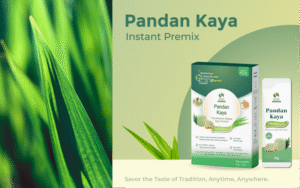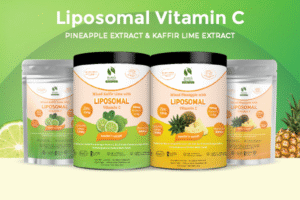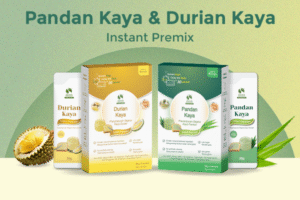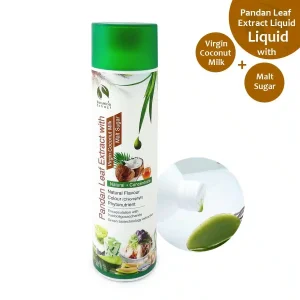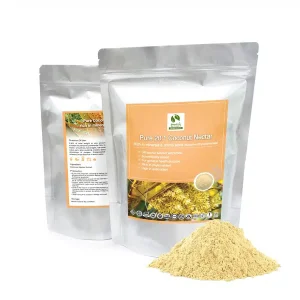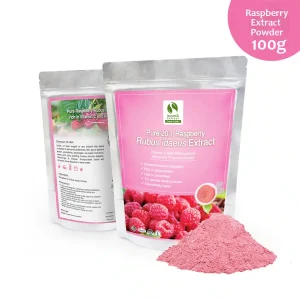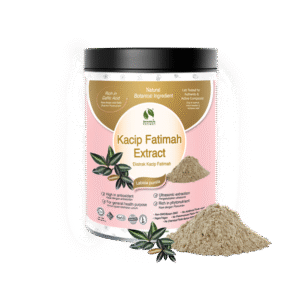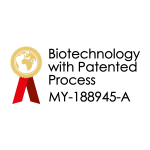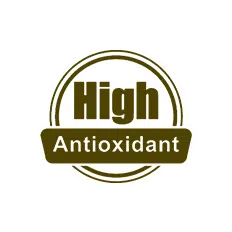Editor’s note: Every other month, HerbalEGram highlights a conventional food and briefly explores its history, traditional uses, nutritional profile, and modern medicinal research. With each article, we also feature a nutritious recipe for an easy-to-prepare dish to encourage readers to experience the extensive benefits of these whole foods. With this series, we hope our readers will gain a new appreciation for the foods they see at the supermarket and frequently include in their diets. We would like to acknowledge ABC Chief Science Officer Stefan Gafner, PhD, and HerbalGram Associate Editor Hannah Bauman for their contributions to this project.
By Jenny Perez, ABC Education Coordinator
Overview
Pineapple (Ananas comosus) is the most economically important member of the bromeliad family (Bromeliaceae) in widespread cultivation. It is a perennial that grows approximately one meter (3.3 feet) tall and has 30 to 40 stiff, straplike, spiked leaves that grow in a rosette around a terminal bud.1-3 The flower stem is short and stout and produces a globular flowerhead covered in up to 200 small lavender-blue flowers.1,2 Pineapples are a compound fruit botanically known as a syncarp and have a thick axis and 100-200 fused fleshy flowers known as fruitlets, with the bracts and sepals arranged in a diamond pattern on the scaly rind.1,2 Pineapple fruits take five to six months to ripen once flowering begins and weigh two to four pounds at harvest.3
Pineapple is a pre-Columbian crop that is native to coastal lowlands of central and northern South America, specifically Brazil and Paraguay.1,2,4,5 The plant thrives in tropical and subtropical regions and is incredibly drought-resistant but sensitive to frost, which is why many plantations are near coastal lowlands.2,6 Unlike many food crops, pollination negatively affects the quality of pineapple fruit by causing it to produce large, inedible seeds. Hummingbirds are the most common pineapple pollinators. In Hawaii, where pineapples were introduced and are produced commercially, laws prohibit the importation of hummingbirds.7
Historical and Commercial Uses
Pineapple traditionally was used throughout South America as a medicine for digestion-related disorders, as an appetite stimulant, and for nausea and even morning sickness.4,5 Pineapple fruit or fruit juice was used as a diuretic to reduce excessive water retention associated with various menstrual conditions or in pregnant women experiencing water retention due to impaired circulation.4 Ground-up pineapple fruit or root was either eaten or applied topically as a poultice to clean infected tissues and stimulate wound healing.5 A pineapple root decoction also has been used to treat diarrhea. The leaves of pineapple have pain-relieving and blood sugar-lowering effects and have been used as an affordable treatment for diabetics experiencing neuropathy (weakness, numbness, and/or pain from nerve damage) and/or neuralgia (intense, typically intermittent pain along the path of a nerve).5,6
Pineapple is known as the “queen of fruits” due to its enjoyable flavor, and its original name comes from the Tupí word nanas, which means “excellent fruit” or “exquisite fruit.”1,7 Its balance of sugars and organic acids contribute to the fruit’s refreshing flavor.5 The species name comosus means “tufted” and refers to the stem of the fruit. In English, the fruit is called “pineapple” due to its pinecone-like appearance and in Spanish, pineapple is known as piña.7 Leaf fibers from the plant are strong, soft, and durable and are used in textiles to produce piña cloth.1,2
The earliest known written references to pineapple were by Christopher Columbus and Spanish colonialist, historian, and writer Gonzalo Fernández de Oviedo y Valdés, who noticed pineapple growing in the West Indies, where it was used for food and making fruit wine.3 In the 1600s, pineapple was so coveted by King Charles II of England that he posed for a portrait depicting him receiving this rare fruit as a gift.7 Since early colonial America, pineapple has been a symbol of hospitality and friendship, appearing as a featured fruit of an entertaining household’s feast and as a motif favored by architects and craftsmen in decorating public buildings, tablecloths, and fine china.1,7
The Tupí-Guaraní peoples were possibly the first to cultivate pineapple, which then spread to the West Indies.1 Thereafter, near the end of the 16th century, the Portuguese and Spanish introduced pineapple to India, China, and present-day Indonesia. The Spanish also introduced pineapple to the Philippines, Hawaii, and Guam.7 Today, nearly 80 countries grow pineapples on a large scale, primarily for juice and canning. Leading producers include Thailand, the Philippines, Brazil, Costa Rica, China, and India.1,3
More than 100 pineapple varieties exist but only six to eight varieties are grown commercially.4 “Smooth Cayenne,” bred for its non-spiny leaves, originated in French Guiana and is grown by about 70% of commercial pineapple plantations. Its cylindrical shape and high sugar and acid content make this variety well adapted to canning and processing.7 Other commercial cultivars include “Pernambuco,” “Queen,” “Red Spanish,” and “Singapore Spanish.”2 In 1997, Del Monte (San Francisco, CA) began marketing its hybrid pineapple, known as MD-2, as “Gold Extra Sweet.”7
Pineapple plantations are in tropical and subtropical regions with sufficient rainfall.4 Pineapples are propagated from the crowns formed above the fruits and from suckers (offshoots) that are produced below the fruit.2 Efficient harvesting of pineapple fruit can be synchronized with continual propagation and planting subsequent harvests by external application of rooting hormone to pineapple crowns. Most pineapple plantations use pineapple crowns for propagation and contain 15,000 to 20,000 plants per acre.3 On pineapple plantations, flowering is sometimes artificially induced, and a second harvest of smaller fruits can be encouraged when the main fruit is harvested early.7
Pineapples can be harvested at an early stage after flowering, allowing multiple harvests each year.4 Maturity level, cultivar type, climate conditions, and postharvest handling all contribute to the optimal nutrients and flavor of ripe pineapple fruit. Pineapples are harvested either by hand or in a semi-mechanized fashion, then sorted and graded according to shape and size and degree of defects. Before packing, pineapples are washed, waxed, treated with fungicide, and dried. Pineapples are then pre-cooled at 55–59 °F for 12 hours to slow ripening, enzyme degradation, and microbial growth. Fresh pineapple has a shelf life of one month if stored at 50–59 °F with 90% relative humidity.
Commercially, pineapple ranks as the third most widely cultivated tropical fruit, after banana (Musa spp., Musaceae) and citrus (Citrus spp., Rutaceae).4 Commonly consumed fresh but available canned worldwide, pineapple is enjoyed as juice, diced for fruit salads, or crushed and added to desserts.3 Pineapple fruit has become a characteristic ingredient in meat, fish, vegetable, and rice dishes of Pan-Asian cuisine. The bromelain in pineapple acts as a natural meat tenderizer.1 In Asia, half-ripe pineapples are used in Vietnamese and Cambodian sour soups and in Indonesian and Malaysian curries. However, unripe pineapples are inedible and toxic, cause throat irritation, and have a strong purgative effect.5
The production and consumption of pineapple fruit creates large amounts of solid waste that can be repurposed while greatly reducing the overall environmental waste. Twenty-five percent of each pineapple plant is lost as waste. With current production and processing practices, efforts are underway that would allow for the complete use of pineapple in the food, cosmetic, and other industries, providing a wide variety of food-based waste processing products with high economic importance.4 Pineapple fibers are renewable, biodegradable, inexpensive, and abundantly available despite being rarely used. Pineapple fiber derived from the crown of the fruit has high flexural rigidity and tensile strength. Pineapple leaf fibers can be used to replace conventional mechanical materials in composites and also are being used in textiles, furniture, automobile and machinery equipment, building and construction materials, sports items, insulators, and more. Pineapple’s crown, core, and peel are commonly discarded but potentially can be repurposed. Pineapple peels, rich in fiber and enzymes, are valuable substrates for bioremediation practices and can be used as biogas generators, producing methane via natural decomposition processes.4
Nutrients and Phytochemicals
Pineapple’s unique aroma, abundant volatile oils, and nutritional and phytochemical compounds make the plant an enjoyable part of healthy diets. Pineapple is considered a low-calorie fruit, containing 55 calories for every 100-gram serving.4 Pineapple primarily contains carbohydrates and water; it provides dietary fiber, sugars, organic acids (citric and malic acids), vitamins (niacin and thiamin), minerals (potassium, magnesium, manganese, and copper), and a complex mixture of volatile oil compounds.4 The volatile ester compounds present in pineapple fruit are associated with the flavor quality of different pineapple varieties.4,8
The ripe fruit, core, stem, peel, and root are the only known natural sources of bromelain, a mixture of protein-digesting enzymes, glycoproteins, and carbohydrates.4,5 Bromelain also contains peroxidase, acid phosphatase, and several protease inhibitors.9 When consumed with meals, pineapple’s bromelain enzyme complex is absorbed intact without losing biological activity and assists in the digestion of proteins, breaking them down into amino acids.5,10 The proteolytic component of bromelain is directly linked to its antibacterial and antiparasitic properties (Table 1).9
Table 1. Nutrients and Bioactive Compounds in Pineapple4,5
| Phytochemical | Compound Type | Plant Part | Associated Properties |
| Vitamin C | Vitamin | Fresh fruit, non-pasteurized fruit juice | Protects cells from free radical damage; supports collagen formation in bones, blood vessels, cartilage, and muscle; slows bone deterioration (osteoblast aging); enhances iron absorption |
| Thiamin | Vitamin | Fruit | Supports red blood cell production and central nervous system function; helps reduce metabolic changes related to diabetes and glucose levels |
| Dietary fiber | Carbohydrate | Fruit, core, stem, peel | Reduces risk of diabetes, colon cancer, and cerebrovascular diseases; improves gastrointestinal function and bowel elimination |
| Manganese | Mineral | Fruit | Vital for energy production, as well as bone and connective tissue formation; modulates blood glucose levels and assists in cholesterol reduction |
| Copper | Mineral | Fruit | Enhances iron absorption and regulates blood pressure and heart rate |
| Bromelain | Proteolytic enzyme | Fruit, core, stem, peel, and root | Anti-inflammatory, cardioprotective, analgesic, wound healing, antiparasitic, antibacterial |
| Malic acid | Organic acid | Fruit | Helps maintain oral health by preventing plaque formation; enhances immunity; promotes smooth, firm skin; reduces risk of heavy metal poisoning |
| Methyl hexanoate, decanal, and geranyl acetone | Volatile oils | Fruit | Contain aromatic compounds |
Modern Research and Potential Health Benefits
Pineapple has been investigated as a food that may naturally support healthy digestion and help reduce swelling associated with sore throat, gout, or arthritis.4 The high dietary fiber content of fresh pineapple can support healthy digestion and elimination. Bromelain is promoted as an alternative to non-steroidal anti-inflammatory drugs (NSAIDs) and is currently manufactured and sold as a dietary supplement for reducing pain and inflammation.6 According to modern research, bromelain has potential uses as an anti-inflammatory and antioxidant with potential benefits for alleviating symptoms of chronic degenerative conditions like arthritis, preventing or minimizing severity of heart attacks, and enhancing oral health as well as post-surgical recovery.4,6,10
Osteoarthritis
Osteoarthritis (OA) is one of the most common and debilitating forms of arthritis worldwide. OA is a chronic, deteriorating joint condition that occurs when the protective cartilage cushion, which keeps bones from rubbing against each other, breaks down, eventually leading to bone touching bone. Contrary to cartilage, bones contain blood vessels and nerves, thus bone friction can cause severe pain and localized inflammation. Current medical treatments are unable to stop the progression of this degenerative condition and therefore focus on pain and inflammation management using NSAIDs, analgesics, localized steroid injections, physical therapy, and, as a last resort, joint replacement surgery.11 Individuals with OA often experience adverse effects, primarily gastrointestinal, with the overuse of NSAIDs. Chronic use of NSAIDs is associated with increased risk of gastric bleeding and ulceration of the stomach lining as well as an increased risk of developing blood clots, which may lead to heart attacks or stroke.12
Bromelain has been investigated as an alternative to NSAIDs for OA patients and other individuals suffering from acute inflammation or sports injuries. It was first studied for its analgesic and anti-inflammatory effects in 1964, when it was used in clinical trials involving people with rheumatoid arthritis and OA.11 The majority of clinical studies that have investigated bromelain for OA have been either open studies (in which neither the participants nor the researchers are blinded) or equivalence studies designed to determine if bromelain-based treatments are as effective and potentially safer than NSAID treatment.
Clinically tested brands include (1) Phlogenzym® (PHL; Mucos Pharma GmbH & Co. KG; Berlin, Germany), a proteolytic enzyme preparation that contains 90 mg of bromelain per tablet as well as trypsin (a proteolytic enzyme) and rutin (a bioflavonoid); (2) Wobenzym® (WOB; Mucos Pharma GmbH & Co. KG), which contains 45 mg of bromelain per tablet as well as rutin, trypsin, chymotrypsin, papain (a proteolytic enzyme from papaya [Carica papaya, Caricaceae]), and pancreatin (which is derived from pig pancreas and contains protease, amylase, and lipase enzymes); and (3) Wobenzym® N (WOB-N; Mucos Pharma GmbH & Co. KG), which contains 45 mg of bromelain per tablet in addition to trypsin, chymotrypsin, pancreatin, and rutin.
Two unpublished studies compared the effectiveness of bromelain (540 mg/day as part of the complexes PHL or WOB) with standard OA treatment: 100-150 mg/day of diclofenac (DF) over a three-week period. Results indicated that PHL and WOB were as effective as DF in reducing OA symptoms. Although the outcome demonstrated no significant improvement by PHL and WOB when compared to DF, participants reported 5% fewer adverse events (mainly gastrointestinal).11 Due to varying methods used in these clinical trials (including dose, duration, and preparations used), it is difficult to draw definite conclusions on the long-term safety and efficacy of bromelain for OA. However, all study outcomes appeared positive, and no serious adverse effects were reported, regardless of the type of preparation or dose used.
Research on bromelain suggests that it may be a safer alternative to NSAIDs for relieving pain and inflammation resulting from acute or chronic injury or disease. Commercially available bromelain supplements are derived from pineapple stem, which contains higher amounts of bromelain than the fruit itself.5 The ways in which bromelain produces these effects are important but complicated. Research indicates that bromelain (1) acts as an anti-inflammatory by increasing fibrinolytic (blood clot-preventing) activity, decreases bradykinin (a peptide causing inflammation) and fibrinogen (a glycoprotein complex involved in the formation of blood clots) levels, which reduces excessive clotting and regulates blood pressure, helping reduce pain and fluid retention (edema); (2) decreases pro-inflammatory, cyclooxygenase (COX)-mediated prostaglandin E2 (PGE2) and thromboxane A2 levels, which are both associated with acute inflammation; and (3) modulates specific immune cell surface adhesion molecules that are typically problematic in the pathogenesis of arthritis.11 Further studies are necessary to fully examine bromelain’s mechanisms of action for its pain-relieving and inflammation-reducing properties.
Cardiovascular Disease
Cardiovascular diseases include blood vessel and heart disorders, heart attacks, stroke, hypertension, heart failure, and congenital heart disease. Research indicates that bromelain can inhibit platelet aggregation, which minimizes the risk of blood clots. Bromelain supplementation may reduce risk factors that contribute to heart disease.10 Additionally, bromelain reduces risk of developing thrombophlebitis (blood clots, usually in the legs) via its potent fibrinolytic activity.
Periodontitis
Periodontitis is a multifactorial disease potentiated by an over-abundance of plaque and harmful bacteria that perpetuate chronic inflammation and deterioration of the tissues surrounding the tooth, including the gums, periodontal ligament, and alveolar bone, possibly leading to tooth loss.9 Once damaged, these tissues are slow to repair themselves. Mechanical therapy includes scaling and root planing along with extensive oral hygiene practices.
Research indicates that use of bromelain as an adjuvant to periodontitis protocols can decrease growth of problematic periodontal microorganisms; proteolytically remove important cell surface molecules (e.g., CD25) in leucocytes (white blood cells); downregulate levels of inflammation mediators; and decrease bone-degrading osteoclasts, reducing alveolar bone loss.9
Bromelain has been extensively used in natural treatments for periodontitis and inhibits the growth of Streptococcus mutans, Aggregatibacter actinomycetemcomitans, and Porphyromonas gingivalis. Research indicates that highly effective extracts can be made using pineapple core. In addition to its antibacterial properties, bromelain reduces inflammation and pain with similar efficacy to NSAIDs. Specifically, bromelain decreases pro-inflammatory cytokines, such as interferon gamma (IFN-γ) and tumor necrosis factor alpha (TNF-α), and down regulates COX-2 expression, which is involved in synthesis of periodontitis-promoting PGE2.9 Bromelain supplementation also is associated with enhanced absorption of antibiotics.10
Acne Treatment
Acne is a common skin condition that affects the skin’s oil glands and can be caused by opportunistic pathogens, including Propionibacterium acnes and Staphylococcus aureus.13 Due to its antimicrobial activity, bromelain can be used clinically to treat acne and folliculitis (condition in which hair follicles become inflamed). The cosmetic use of bromelain is similar to that of papain in papaya in smoothing wrinkles and soothing dry skin.
Aside from the fruit and stem, pineapple peels have the highest bromelain content and therefore the strongest proteolytic activity of all pineapple parts tested.10,13 The presence of bromelain in plant parts that are typically discarded during pineapple processing creates an opportunity to reduce waste and extract bromelain for skincare purposes. Research suggests that a facial wash prepared with bromelain — in addition to turmeric (Curcuma longa, Zingiberaceae) extract, tea tree (Melaleuca alternifolia, Myrtaceae) oil, sodium laureth sulfate, propylene glycol, sodium hydroxide, sodium stearate, and xanthan gum — had antimicrobial effects on bacteria common in the occurrence of acne, particularly P. acnes and S. aureus.13
Consumer Considerations
Unlike bananas, pineapples are cold-sensitive and should be kept at room temperature, not refrigerated. Under normal conditions, the starches in pineapple fruit do not get sweeter after harvest, so the fruit must be picked ripe and ready for consumption. Once ripe and brought home from the market, pineapples should be consumed within a day or two before over-ripening, when texture and sugar content begin to change dramatically.4
When selecting fresh pineapple, it is good to choose fruits that feel heavy for their size and have firm, plump skin, uniform scales, and a tropical aroma.1 Leaves should be fresh and green.14 Whenever possible, eat fresh pineapple for optimal nutrient absorption and health benefits. Commercially produced fresh pineapple juice will still contain bromelain but will have lost some antioxidant activity due to the loss of vitamin C and other heat-sensitive nutrients.4
Consuming too much pineapple is sometimes associated with sore throat and/or mouth. Consuming pineapple products is contraindicated for individuals who take medications such as benzodiazepines, barbiturates, antidepressants, and antibiotics as it will speed up the metabolism of these drugs.4 This includes the use of bromelain supplements. The most frequently reported adverse effects associated with the use of bromelain include upset stomach and diarrhea.6
Nutrient Profile15
Per 1 cup pineapple chunks (approx. 165 g)
Macronutrients:
82.5 kcal calories
0.89 g protein
21.6 g carbohydrate
0 g fat
Micronutrients:
Excellent source of:
Vitamin C: 78.9 mg (87.7% DV)
Manganese: 1.53 mg (66.5% DV)
Copper: 0.18 mg (20% DV)
Good source of:
Pyridoxine (Vitamin B6): 0.19 mg (11.2% DV)
Thiamin (Vitamin B1): 0.13 mg (10.8% DV)
Also provides:
Dietary Fiber: 2.31 g (7.7% DV)
Folate: 29.7 mcg (7.4% DV)
Niacin: 0.83 mg (5.2% DV)
Magnesium: 19.8 mg (4.7% DV)
Potassium: 180 mg (3.8% DV)
Riboflavin: 0.05 mg (3.8% DV)
Iron: 0.48 mg (2.7% DV)
Zinc: 0.198 mg (1.8% DV)
Calcium: 21.4 mg (1.6% DV)
Phosphorus: 13.2 mg (1.1% DV)
Vitamin K: 1.16 mcg (1.0% DV)
Vitamin A: 4.95 mcg (0.6% DV)
DV = Daily Value as established by the US Food and Drug Administration, based on a 2,000-calorie diet.
Recipe: Quick and Easy Pineapple Fried Rice
Courtesy of Allrecipes.com16
Ingredients:
- 2 cups cold, cooked white rice
- 2 tablespoons vegetable oil
- 1/2 cup diced sweet onion
- 1 tablespoon grated ginger root
- 1 clove garlic, minced
- 1 1/2 cups fresh pineapple chunks
- 1/2 red bell pepper, stemmed, seeded, and diced
- 1/3 cup frozen peas
- 2 tablespoons low-sodium soy sauce, or to taste
- 1 teaspoon sesame oil
- 2 tablespoons sliced green onion
- 1 teaspoon toasted sesame seeds
Directions:
- Add oil to skillet and heat over medium. Add diced onion and cook for about 1 minute. Add ginger and garlic and cook, stirring constantly, for 1 minute.
- Increase heat to medium-high; add pineapple, red bell pepper, and peas. Cook, stirring constantly for 3 to 4 minutes. Stir in rice and soy sauce, and cook until ingredients are well integrated, 1 to 2 minutes. Stir in sesame oil and remove from heat.
- Garnish with sliced green onions and sesame seeds before serving.
Image credits (top to bottom):
Ananas comosus. ©2021 Steven Foster.
Francisco Manuel Blanco, Flora de Filipinas. 1837.
Ananas comosus flower. Image courtesy of Anonymous Powered.
Ananas comosus. ©2021 Steven Foster
References
- National Geographic Society. Edible: An Illustrated Guide to the World’s Food Plants. Lane Cove, Australia: Global Book Publishing; 2008.
- Van Wyk, Ben-Erik. Food Plants of the World. Portland, OR: Timber Press; 2005.
- Pineapple. Britannica Online Encyclopedia. Available at: www.britannica.com/print/article/460976. Accessed on April 15, 2021.
- Ali M, Hashim N, Aziz S, Lasekan O. Pineapple (Ananas comosus): A comprehensive review of nutritional values, volatile compounds, health benefits, and potential food products. Food Research International. 2020;137:1-13.
- Houssain MF, Akhtar S, and Anwar M. Nutritional value and medicinal benefits of pineapple. International Journal of Nutrition and Food Sciences. 2015;4(1):84-88.
- Bromelain. NIH National Center for Complementary and Integrative Health. Available at www.nccih.nih.gov/health/bromelain. Accessed on May 28, 2021.
- Pineapple. New World Encyclopedia online. April 2008. Available at: www.newworldencyclopedia.org/p/index.php?title=Pineapple&oldid=682322. Accessed April 15, 2021.
- Wei CB, Liu SH, Sun GM. Characteristic aroma compounds from different pineapple parts. Molecules. 2011;16(6):5104-5112.
- da Silva FR, Vasconcelos AC, Pereira Alves EH. Bromelain: A potential strategy for the adjuvant treatment of periodontitis. Dental Hypothesis. 2016;7(3):88-93.
- Pavan R, Jain S, Kumar S, and Kumar A. Properties and therapeutic application of bromelain: a review. Biotechnology Research International. 2012;976203.
- Brien S, Lewith G, Walker A, Hicks S, et al. Bromelain as a treatment for osteoarthritis: A review of clinical studies. Evidence-Based Complementary and Alternative Medicine. 2004;3(1):251-257.
- Diclofenac. Drugs.com website. Available at: www.drugs.com/diclofenac.html. Accessed on April 28, 2021.
- Abbas S, Shanbhag T, Kothare A. Applications of bromelain from pineapple waste towards acne. Saudi Journal of Biological Sciences. 2021(28)1001-1009.
- Dole pineapple plantation. Selecting a Pineapple. Available at: www.doleplantation.com/resources/#resources-tabs|1. Accessed on June 28, 2021.
- Pineapple. USDA Food Data Central. Available at: https://fdc.nal.usda.gov/fdc-app.html#/food-details/169124/nutrients. Accessed on May 28, 2021.
- Quick and Easy Pineapple Fried Rice. Allrecipes.com. Available at: www.allrecipes.com/recipe/281154/quick-and-easy-pineapple-fried-rice/. Accessed on June 24, 2021.


